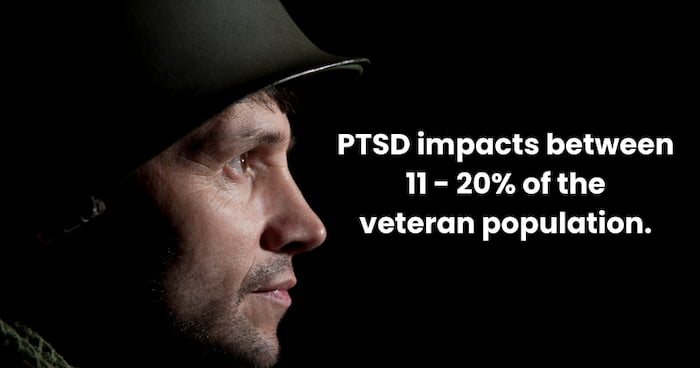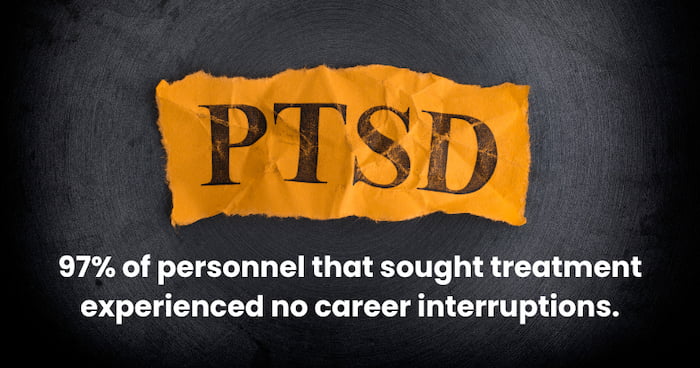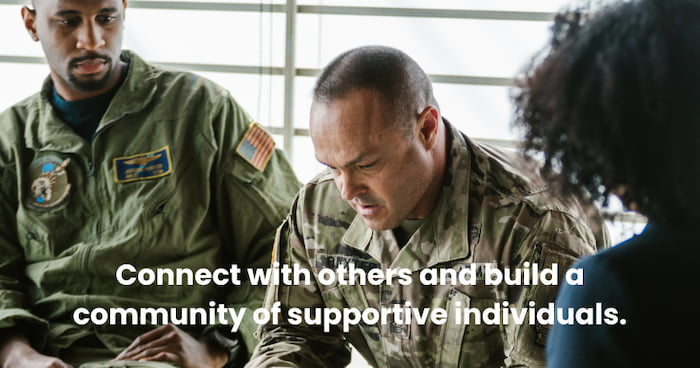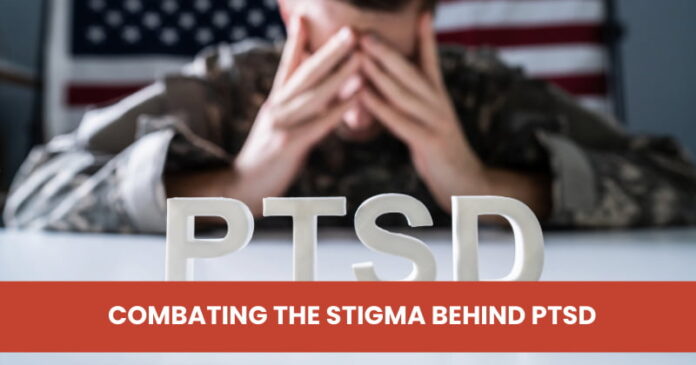PTSD and mental health issues in veterans are severely underreported. Why? Stigma. Dealing with PTSD and mental health issues is a profoundly personal and scary experience. Those who have experience with this often feel isolated and alone. These feelings contribute to the stigma surrounding mental health.
For years, these disorders have been misunderstood, mischaracterized, and the behavior of people with PTSD and mental health disorders is often misinterpreted. In recent years, the mental health and veteran communities have developed a strong partnership to break down barriers and reduce stigma.
This article will discuss the signs and symptoms of PTSD, the stigma surrounding PTSD and mental health in veterans, the efforts being taken to reduce stigma in the veteran community, and how you can help.

What is PTSD?
PTSD, otherwise known as Post Traumatic Stress Disorder, can develop due to exposure to a traumatic event. It presently impacts between 11-20% of the veteran population. Undiagnosed and untreated, PTSD can last months, if not years. Symptoms of PTSD and other mental health disorders can manifest in various ways. Some of the most common include:
● Intrusive Memories
● Avoidance
● Negative mood swings
● Physical or emotional detachment
● Suicidal thoughts or ideations
In addition to symptoms manifesting in multiple ways, PTSD and other mental health disorders can take weeks or months to manifest after witnessing a traumatic event. PTSD and mental health disorders are not one-size-fits-all.
If you or someone you know has witnessed a traumatic event, it’s important to keep an eye out for any symptoms so you can seek the help you need or encourage your loved one to seek the help they need to get better. PTSD and many other mental health disorders that result from service are treatable!
The Stigma Surrounding Veterans with PTSD and Mental Health Disorders
The stigma surrounding PTSD and mental health issues is one of the contributing factors to veteran suicide. Stigma is a mark or characteristic of disgrace associated with a particular circumstance, quality, or person.
Those suffering or confined by stigma can suffer from stereotyping, bullying, harassment, isolation, discrimination, and limited access to employment and community-centric activities.
Specifically, in the military, where strength, toughness, and mental clarity are revered. It can be scary to seek treatment and help for PTSD and mental health disorders that are seen as “weak” or “dangerous.” Many veterans face something called self-stigma rather than community-induced stigma.
Self-stigma occurs when an individual holds demeaning or degrading beliefs about a particular trait or characteristic and accepts that others hold the same belief. Self-stigma is one of the biggest aspects working against veterans and military members with PTSD and mental health disorders.

Another aspect of self-stigma among military personnel and veterans is the belief that reporting PTSD and mental health disorders could lead to unemployment. Guess what? In 2006, a study found that 97% of personnel who sought treatment experienced no career interruptions. Self-stigma strikes again!
Fighting stigma starts from within ourselves and spreads to the larger community.
Reducing Stigma in the Veteran Community
The Department of Veterans Affairs and many non-profit veteran groups have worked tirelessly to reduce the stigma surrounding PTSD and mental health disorders. Two larger programs include the Salute to Recovery Program and the Community Care Program.
Both programs are geared toward connecting veterans and military personnel with resources to address PTSD and mental health disorders and actively fighting stigma with information and research.
Those are just some of the two programs available to help veterans and help fight stigma. We encourage all veterans and military personnel suffering or wanting to join the cause to fight stigma to reach out to their local VA offices.

You can also fight stigma within yourself and do the work of fighting stigma in your immediate circles and local community with some of the following methods:
● Spread accurate information and ignore misinformation. Spread and communicate information from reliable sources such as VA.gov and other scientific studies and resources.
● Connect others to or build a community of supportive individuals. Community is key! When you have supportive people around you or can connect someone struggling with a supportive community will help so much on the road to recovery!
● Practice mindfulness exercises and actively fight self-stigma. PTSD and mental health disorders do not define you or your loved ones. Fighting self-stigma is the first and largest step we can take to fight the stigma around PTSD and mental health in veterans and military personnel!
If we work as a community to combat the stigma faced by military personnel and veterans, we can continue to improve the lives of those who have sacrificed for this country. For local resources, reach out to your local VA office.
Read Also
- Revolutionizing Patient Engagement: Innovative Solutions for Improved Care and Treatment SuccessNavigating healthcare system can often feel overwhelming for patients. Between appointments, prescriptions, and treatment regimens, it’s easy for crucial details to get lost in the shuffle. That’s why effective patient engagement and support solutions are more important than ever. Companies like Serva Health, with their pharma hub services, are stepping up to ensure that patients… Read more: Revolutionizing Patient Engagement: Innovative Solutions for Improved Care and Treatment Success
- On-Demand Healthcare Staffing As A Cost-Saving StrategyThis is an exciting and challenging time for the healthcare industry. Technology is advancing almost faster than humans can keep pace. New legislation is creating fresh challenges for the future of healthcare, and the shifting population demographic continues to place more pressure on healthcare facilities. Amidst these changes, healthcare facilities are facing a critical staffing… Read more: On-Demand Healthcare Staffing As A Cost-Saving Strategy
- The Future of Men’s Health: Why Telehealth Is Here to StayTelehealth isn’t just a pandemic trend that faded into the background. For Australian men, it has become one of the most practical, time-saving, and stress-free ways to manage everyday health — and it’s shaping the future of how we access care. Platforms like DOCTO, an Australian online doctor and specialist telehealth service, are leading the… Read more: The Future of Men’s Health: Why Telehealth Is Here to Stay
- Plastic Injection Molding Solutions: Precision, Efficiency, and Innovation Shaping Modern ManufacturingPlastic injection molding has become one of the most essential manufacturing processes across global industries. From medical devices and aerospace components to industrial equipment, electronics, and consumer goods, companies rely on molding solutions that deliver accuracy, consistency, and scalability. As demand grows for tighter tolerances, specialized materials, and more complex geometries, manufacturers increasingly partner with… Read more: Plastic Injection Molding Solutions: Precision, Efficiency, and Innovation Shaping Modern Manufacturing
- Automated Healthcare Software Solutions: How Intelligent Platforms Are Redefining Clinical, Administrative, and Operational ExcellenceThe healthcare industry is undergoing a seismic transformation. Rising patient volumes, value-based care models, staffing shortages, and complex regulatory demands have prompted organizations to look beyond traditional tools and embrace advanced software automation. As providers search for innovative partners capable of tailoring these sophisticated systems to real-world workflows, many turn to MCSI (Managed Care Systems,… Read more: Automated Healthcare Software Solutions: How Intelligent Platforms Are Redefining Clinical, Administrative, and Operational Excellence
- How to Build a Simple, Clean Skincare Routine ?You don’t need a complicated skincare routine. It doesn’t have to be something that requires twenty different products and confusing steps. Your routine works well with just a few high-quality clean ingredients. The beauty industry keeps pushing more products, but your skin actually needs less. You only need a simple approach to get better results… Read more: How to Build a Simple, Clean Skincare Routine ?







